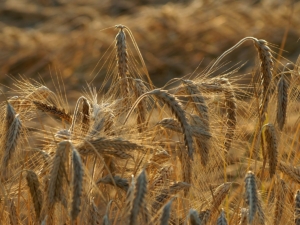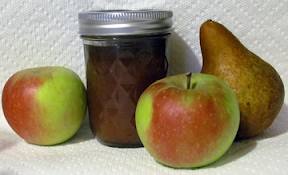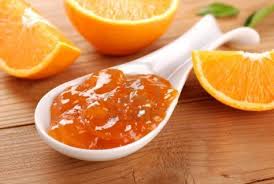 As an experiment, last year I acquired seeds for ten varieties of wheat and four of barley from Salt Spring Seeds and other sources and planted a small test row of each variety in my garden. After initial watering no further water was provided to the growing grain other than rainfall. Germination rates varied among the varieties but all produced grain, which was harvested in late September. In addition to the amount of grain produced, I wanted to see how susceptible the different varieties were to “lodging”, i.e. falling over in wind or rain due to height and top-heaviness of the seed head. Wheat breeders for many decades have selected for shorter, sturdier plants, and more recently for hull-less and bristle-less seed heads to make threshing easier.
As an experiment, last year I acquired seeds for ten varieties of wheat and four of barley from Salt Spring Seeds and other sources and planted a small test row of each variety in my garden. After initial watering no further water was provided to the growing grain other than rainfall. Germination rates varied among the varieties but all produced grain, which was harvested in late September. In addition to the amount of grain produced, I wanted to see how susceptible the different varieties were to “lodging”, i.e. falling over in wind or rain due to height and top-heaviness of the seed head. Wheat breeders for many decades have selected for shorter, sturdier plants, and more recently for hull-less and bristle-less seed heads to make threshing easier.
Wheat varieties tested included Emmer, an ancient Near Eastern wheat, and Kamut, another ancient wheat with high protein content. Also grown were Ethiopian, Egyptian, Brazilian, and Mexican wheats. A trio of Canadian heirloom wheat varieties was also grown, including Red Fife (originating in 1885), Marquis (1910), and Thatcher (1935), which made up 70% of the Canadian prairie wheat crop in the 1950s. As expected, yields of the ancient wheats were lower than the more modern (century old) varieties. For example, Red Fife grain produced in my test plot would have yielded almost 3000 pounds of grain per acre if scaled up. (Once milled, that would be enough flour to bake 5000 loaves of bread.)
Wheat and other grains were being grown on the Saanich Peninsula and the Gulf Islands in the late 1880s, but the availability of mass-production prairie-grown grain put an end to the practice. There has recently been a mini-revival of grain growing on Vancouver Island, and The Roost bakery and cafe on East Saanich Road sells bread made from locally grown wheat. Who knows, we may see a grain-growing revival on Galiano too!
 Learn how to make homemade applesauce or Pear Butter that is much tastier than store bought, perfect for school lunches or serving with latkes. Please bring 4 x 250ml jars and any apples (from your own apple trees only please).Fingers crossed we will be using apples or pears from the Gleaning program.
Learn how to make homemade applesauce or Pear Butter that is much tastier than store bought, perfect for school lunches or serving with latkes. Please bring 4 x 250ml jars and any apples (from your own apple trees only please).Fingers crossed we will be using apples or pears from the Gleaning program.
 More summer in a jar! We’ll be making jam the old-fashioned way. Long boil style, with the wrinkle test and thermometers, and canning it using a boiling water bath. Alison will demonstrate jelly-making, and we’ll put up one kind of marmalade. There will be a discussion on the various pectin levels of different fruits at different times of the year.
More summer in a jar! We’ll be making jam the old-fashioned way. Long boil style, with the wrinkle test and thermometers, and canning it using a boiling water bath. Alison will demonstrate jelly-making, and we’ll put up one kind of marmalade. There will be a discussion on the various pectin levels of different fruits at different times of the year. Pickled foods offer intense flavours to enhance your winter diet. By preserving local crops now when they are at the height of freshness, you can capture their best flavour and nutrition.
Pickled foods offer intense flavours to enhance your winter diet. By preserving local crops now when they are at the height of freshness, you can capture their best flavour and nutrition. Galiano summers yield an amazing variety of tree fruits and berries, available from our farmers, through our Gleaning program and in your own backyard. Making jam is a great way to capture the taste of summer in a jar to brighten up those dark winter days.
Galiano summers yield an amazing variety of tree fruits and berries, available from our farmers, through our Gleaning program and in your own backyard. Making jam is a great way to capture the taste of summer in a jar to brighten up those dark winter days. As an experiment, last year I acquired seeds for ten varieties of wheat and four of barley from Salt Spring Seeds and other sources and planted a small test row of each variety in my garden. After initial watering no further water was provided to the growing grain other than rainfall. Germination rates varied among the varieties but all produced grain, which was harvested in late September. In addition to the amount of grain produced, I wanted to see how susceptible the different varieties were to “lodging”, i.e. falling over in wind or rain due to height and top-heaviness of the seed head. Wheat breeders for many decades have selected for shorter, sturdier plants, and more recently for hull-less and bristle-less seed heads to make threshing easier.
As an experiment, last year I acquired seeds for ten varieties of wheat and four of barley from Salt Spring Seeds and other sources and planted a small test row of each variety in my garden. After initial watering no further water was provided to the growing grain other than rainfall. Germination rates varied among the varieties but all produced grain, which was harvested in late September. In addition to the amount of grain produced, I wanted to see how susceptible the different varieties were to “lodging”, i.e. falling over in wind or rain due to height and top-heaviness of the seed head. Wheat breeders for many decades have selected for shorter, sturdier plants, and more recently for hull-less and bristle-less seed heads to make threshing easier.